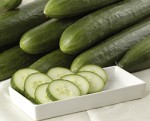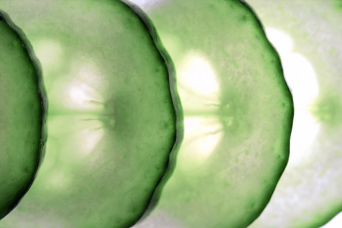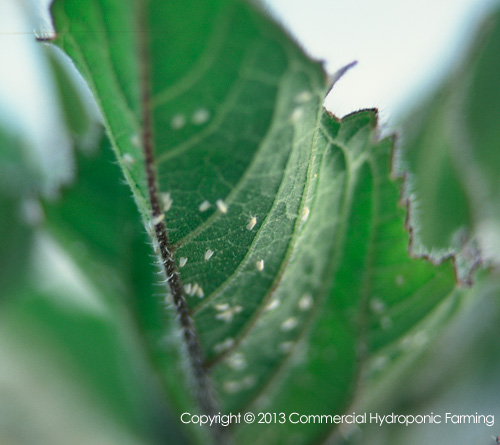The basics of growing cucumbers in hydroponic greenhouses
Establishing the cucumber crop
Cucumbers are tropical plants. In order to grow optimally a tropical environment should be created. This implies that temperatures should not exceed 32 °C and should also not fall below 16 °C. These are optimum values and are not always obtainable. Cucumber seedlings are sensitive to low temperatures. The ideal germination temperature is between 25 °C and 30 °C. Temperatures below 12 °C will reduce the germination percentage significantly. It is clear that optimal germination requires a high degree of temperature management in the area where the cucumbers are growing. It is also important to select varieties that are not that sensitive to temperature, especially during the initial growth phase.
The cucumber seedling is probably one of the most rapid growers of all vegetables. This could be ascribed to the seed size. It has been found that stem extension and leaf development is linearly dependant on a mean air temperature between 18.5 °C and 27 °C. Temperatures above 28 °C reduce the growth tempo of the plant. At these high temperatures it does not stop growing, it is just not growing at an optimal rate. It is important that day temperatures should be higher than night temperatures, this actually applies to all vegetables. If night temperatures are higher than day temperatures growth rate is impeded. During the initial stages the difference between day and night temperatures should not exceed 6 to 8 °C. Low night temperatures reduce shelf life, increases malformed fruit and results in a pale scar tissue forming.

The seeds of the English cucumber are soft compared to the cucumbers grown in fields. Most people prefer English cucumbers in salads.
The root temperature of cucumbers is critical. Temperatures below 16 °C will result in root death and poor top growth. At these temperatures nutrient uptake is also impaired. Optimal growth is between 20 and 26 °C with root temperatures between 22 °C and 25 °C.
Leggy plants never catch up on young hardened off seedlings. Seedlings with more than four true leaves are already to old. Leggy plants should not be planted deeper in order to compensate for their length.
Cucumber planting density
Planting density is slightly lower than that of peppers and tomatoes. However the same path widths can be used. The ideal path width is at least 1.8 m since cucumber leaves are so big and tend to close the path which makes to difficult to move between plants. Plants are planted in double rows with the double row at least 450 mm – 500 mm apart and plants are spaced 400 mm – 450 mm apart. The average number of cucumber plants per hectare, including paths and other wasted space, is 1.4 – 1.8 plants per square meter. That amounts to 14,000 – 18,000 plants per hectare.
Temperature and humidity requirement of cucumbers
Much has been said about the optimum germination and seedling growing temperatures in first section. It has been mentioned that cucumbers are tropical plants and require a tropical environment to grow optimally. Tropical temperatures do not vary much, they vary between 22 and 30 °C during the day and 16 to 18 °C during the night. By keeping the night temperatures below 18 °C and increasing the root temperature, significant increases in yields have been found. Increasing temperatures during the day increased stem extension and reduced time to harvest and harvest period but did not increase total yields. The relative humidity is extremely important and should never be seen as a separate entity when growing cucumbers. Ideally the RH should vary between a minimum of 75 % and a maximum of 95 %. RH below 75 % increases transpiration rate which can be higher than the water uptake rate that the plant can handle. Growing in to high RH results in the formation of thin leaves that are prone to disease attack. To high RH also cause fruit to be excessively ribbed and spines grow excessively. The reason why cucumbers are so sensitive to low RH and temperatures is the size of their leaves. The have a very large area relative to their root volume if compared to tomatoes and peppers. Ideally cucumbers should be grown in a greenhouse since the South African temperatures are so high and the RH so low. Except for the coastal areas, Mpumalanga and the Northern Province, the RH varies between 35 % and 55 % which is much to low for growing cucumbers in shade cloth structures.
Temperature, light and photoperiod has a significant effect on sex expression of cucumber flowers. In general low mean day temperatures favour the development of female flowers and high mean night temperatures favour the development of male flowers. High light conditions, such as those found throughout South Africa, favour the development of female flowers and low light conditions delays the onset of female flowering. This is important for greenhouses with old plastic. Old plastic is less transparent and may have a significant influence on yields. During periods of low light and high temperatures the development of male flowers are favoured. Day length, or photoperiod, has an influence on sex expression but not as significant as light intensity. Short photoperiods favour female flower development.
Female flower production is delayed and male flower production favoured with high nitrogen levels and high planting densities. The high planting densities probably reduce the amount of light reaching the plants.
Conditions that favour the build-up of carbohydrates and reduce vegetative growth will favour female flower development while conditions that favour stem elongation and reduce carbohydrate build-up such as high temperatures, low light conditions, high planting densities and short days will favour male flower development.
Share This Story, Choose Your Platform!
Cotton aphid – Aphis gossypii
Cotton Aphid, or Aphis gossypii, is one of the more common insect pests found in almost all vegetable crops and [...]
Greenhouse white fly
Description Greenhouse white fly, also known as Trialeurodes vaporariorum is a sap feeder. The easiest way to find white flies [...]








